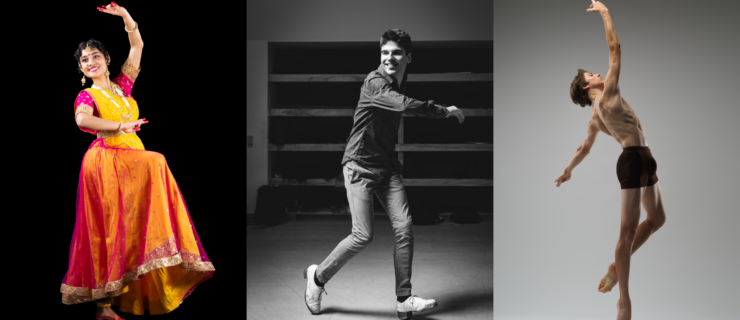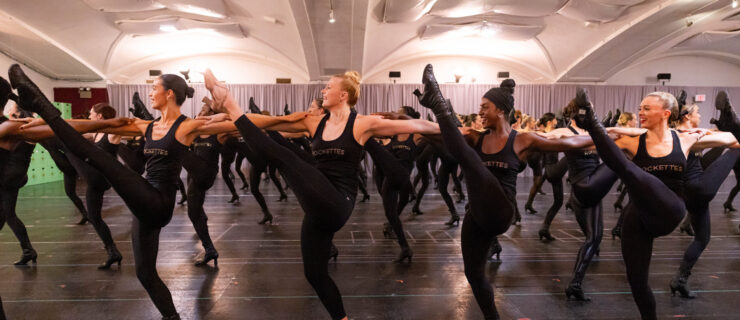The Dos and Don'ts of Partnering
Few things are as nerve-racking as partnering class, especially when you’re a newbie. No matter the genre, the stakes feel high—and the potential for awkwardness feels unlimited. How do you avoid smacking your partner in the face? How do you communicate a problem without causing a major conflict? Dance Spirit spoke with some partnering pros to bring you answers to those questions and more.
Common Partnering Pitfalls
1. Deflecting Responsibility
None of us will be perfect partners at all times, especially when we’re first learning. When we begin working with a teammate, it can be tempting to deflect responsibility for our weaknesses onto them. Resist the temptation!
“None of us likes to be wrong, so it can feel like a necessity to interpret your actions as correct, and your partner’s actions as wrong,” says L.A.-based choreographer Phillip Chbeeb. “That can be one of the most damaging dynamics in a partnership. Instead, assume that you have the power to adjust and assuage the problem. If you both maintain this mindset, you will always be able to move forward together.”
One of the primary ways partners who are being supported can take responsibility is by simply holding their weight. “A common misconception is that the person doing the lifting is doing all the work, but a good partner is in complete control of their body even when it looks like they’re surrendering,” says choreographer Stacey Tookey. “You have to be solid on your own,” says Houston Ballet principal Karina González. “You can’t expect your partner to save you. You have to be comfortable on your supporting leg, whether your partner is there or not.”
2. Lacking Spatial Awareness
Worried about smacking your partner in the face? First, just accept that it’s going to happen from time to time. “It’s the nature of the beast,” Tookey says. Then, put in the work to become aware of the space around and between the two of you.
Assess your height difference, if there is one, and how it affects the choreography. Can you identify predictable points of impact that can be avoided with slight shifts in positioning? This dynamic will vary from partnership to partnership, so be patient as you work through the kinks.
To improve your spatial awareness while partnering, “Dancing with the Stars” pro Emma Slater recommends trying dance styles that require you to switch partners often. “Go to social dance events, or to dance classes that have an uneven number of men and women,” Slater says. “Doing so will help you get comfortable dancing with a range of artists.”
3. Discounting Differences
Just as no two people are the same, no two partnerships will be the same, either. But don’t think of the differences between you and your partner as obstacles to overcome. Instead, reframe them as opportunities to make the most of.
Whenever Chbeeb sets choreography on pairs, he reminds himself not to get married to any of the work, because it will likely need to be altered to allow the different bodies to mesh well together. “I embrace the variety in body types and strengths,” Chbeeb says. “I look to see what unique things these two specific bodies can create together.”
When creating a duo with a partner, Chbeeb likes to discover those possibilities by working with his counterpart—without music. “That way, we don’t have limitations to the timing of the shapes we create,” he says. “If we stumble across something that works well for our two bodies, we can record it, making a collection of phrases to pull from. Then we can turn on the music and see what translates over.”

(From left) Tyler Gledhill, Chelsea Thedinga, and Corey John Snide rehearsing a work by Stacey Tookey (Anna Marchiscello, courtesy Stacey Tookey)
Partnering Best Practices
1. Communicating Productively
Being able to communicate respectfully and effectively with a partner is something that, like any dance skill, takes practice. But it’s critical to any partnership’s success.
González has found that taking the extra time to think through the phrasing of a correction or question makes all the difference. “Be careful about how you speak,” she says. “Take blame out of the conversation altogether, and respectfully communicate your concerns while being open to listening to a different perspective.” Chbeeb recommends asking your partner what things they feel you could improve on. Doing so might encourage them to ask the same of you, allowing the two of you to approach corrections on an even footing.
Spending some time with your partner in a nondance setting, if possible, can help the two of you figure out a successful communication style. “During ‘So You Think You Can Dance,’ the dancers often only get to work together for a handful of hours before they perform,” Tookey says. “I recommend they meet outside of the studio and get to know each other so conversation comes more naturally. The more you know each other, the better things will go.”
What about the opposite problem, when you and your BFF get paired together and can’t stop chatting? “Remind yourself that you have to be focused,” González says, because the stakes are high: There’s potential for injury if you aren’t. “You can even schedule time to talk later, outside of the studio, so that when you’re in rehearsal or class, you can keep things professional,” González says.
2. Establishing and Respecting Physical Boundaries
It’s important to state your boundaries outright. Partnering is inevitably intimate, but it should never cross hard lines set by you, your partner, and your teacher or choreographer. “If something doesn’t feel right, you should communicate that to your partner and teacher,” González says. “It could be that they didn’t realize what was happening in the tangle of partnering. Or, it could be that they did cross a line, and that needs to be addressed immediately.” Remember that boundary-setting goes both ways, so be ready to listen and adjust when your partner shares concerns.
It’s also common to implicitly associate physical touch with romantic feelings, which can complicate partnering situations. “Many who’re new to partnering immediately associate touch with something that isn’t dance,” Chbeeb says. “This can make professionalism difficult, and hold you back artistically. Try to reframe your perspective, so that you’re not interpreting movement as anything other than art.”
3. Being Thoughtful About Clothing and Hygiene
Look, dance is inevitably sweaty and messy—that’s part of what makes it beautiful! But to be a considerate partner, it’s worth thinking about your clothing and hygiene choices.
Chbeeb points out that it’s important to choose clothes that won’t inadvertently hurt your partner. For example, avoid wearing items with zippers, since they can scratch skin. Going shirtless? Sweaty skin can be dangerously slippery, so keep a towel handy. If you have longer hair, and it’s not involved in the choreography, consider pinning it back so it doesn’t whip your partner in the face.
Breath and body odor questions are complicated—opinions differ widely when it comes to bodily hygiene. But Chbeeb recommends showering or taking a breath mint before partnering if you know that you’ll feel self-conscious otherwise. “You don’t want to end up wasting mental space thinking about how you smell rather than the choreography,” he says.

González and Walsh rehearsing Sylvia (Amitava Sarkar, courtesy Houston Ballet)
Partnering During a Pandemic
In our new #SocialDisDancing reality, IRL partnering is often impossible. But there are steps you can take to get ready for the moment when we can all be together again.
Chbeeb recommends practicing by using items from around the house as partnering props. “I have always found that working with props stimulates a very similar portion of the brain as partner work,” he says. “You get used to the idea of creating visuals that extend beyond your own body. Pick up anything portable—a frying pan!—and use it in a way you had never considered before. Then, apply the discoveries you make with your partner when you come together in person.”
González recommends cross-training to develop the strength you’ll need to be an effective partner. “Focus on leg and upper-body strength, which will help with lifting,” she says. And core exercises will help you support your own weight during complicated partnering work.
You can also use this time alone to get inspired by other great partnerships. Watch YouTube videos of partners in different dance genres and styles, thinking about what it is that makes their collaboration work—mechanically, and also on an intellectual level. “Look to the amazing dancers who have been partnering for years, and apply the strengths you see in them to your own dancing when you return,” González says.




